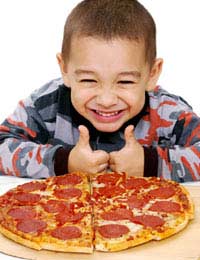
Most children enjoy food and they’re often intrigued to know more about what you’re doing when you’re preparing meals in the kitchen. Help children discover more about cooking and trigger a lifelong interest in food, by learning about cooking.
Learning in the Kitchen
If your child shows interest in what you’re doing when you’re busy in the kitchen, then it’s time to get them more involved and help increase their knowledge about cooking.
Young children will no doubt ask questions, such as “What are you doing?” or “What’s that?” Even though their inquisitive questions may interfere with your train of thought or interrupt what you’re doing, it’s good to take the time to stop and answer their queries. You can also initiate interest by asking them what you think things are.
Successful cooking involves the ability to properly read and follow a recipe, putting the correct ingredients in and combining or mixing them up in a certain order. These are all skills that children can learn and that will help build up their interest in and knowledge of cooking. Talk to your children about recipes, show them recipes in a book or your own recipe cards and demonstrate how you need to follow the recipe in order to cook food.
It doesn’t have to be hard work and you can incorporate games in or around learning about cooking. For example, you could develop a memory game where you read out a recipe, ask your child to listen carefully as you read it and then get them to name as many of the ingredients as they can. Another variation of it would be to ask them to remember what to do first in the recipe, or how different ingredients are mixed together.
Cooking Together
Getting children actively involved in cooking is one of the best ways of helping them develop a keen interest in food and cooking. If they’ve actually done it themselves, on a practical basis, there’s also more of a chance that they’ll remember their experiences and how they produced and cooked foods.
Simple recipes, such as making cakes, scones or biscuits, are ideal for cooking with children. Depending on the age of your child, you could either weigh out and prepare all the ingredients in advance, or they could be involved in weighing them out for themselves. Weighing ingredients teaches important skills too, as children have to learn how to use weighing scales and measure out correct amounts of ingredients.
You could follow the recipe together, or you could read out what needs to be done next, with your child adding the ingredients to the bowl and helping mix it all up. Recipes that don’t take too long to cook are good for young children with short attention spans and you can guarantee they’ll be keen to help you taste their efforts when it’s baked and ready!
Learning About Food Ingredients When Out Shopping
Children can learn a lot about the many different types of food ingredients when you’re out shopping. To help prevent boredom in supermarkets, children can help you find items on your shopping list, with assistance, and tick off the items as you go along.
Fruit and vegetable aisles, or greengrocer shops, can provide a wealth of learning opportunities for young children, as they get to see fruits and vegetables up close. If their previous knowledge is mostly gained from books or television, or hearing you talk about certain items, it can be really informative to see products for themselves. If the shop isn’t too busy, you could get children to hunt and find items for you, which can take some guessing if they’re unsure of what the produce actually looks like.
In addition, you can chat about how you’d use it once you’d get it back home, what sort of recipes you’d cook and the different ways in which the produce can be prepared and cooked.





Leave A Comment